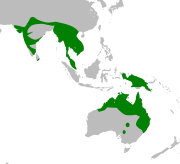Superregnum: Eukaryota
Cladus: Unikonta
Cladus: Opisthokonta
Cladus: Holozoa
Regnum: Animalia
Subregnum: Eumetazoa
Cladus: Bilateria
Cladus: Nephrozoa
Superphylum: Deuterostomia
Phylum: Chordata
Subphylum: Vertebrata
Infraphylum: Gnathostomata
Megaclassis: Osteichthyes
Cladus: Sarcopterygii
Cladus: Rhipidistia
Cladus: Tetrapodomorpha
Cladus: Eotetrapodiformes
Cladus: Elpistostegalia
Superclassis: Tetrapoda
Cladus: Reptiliomorpha
Cladus: Amniota
Classis: Reptilia
Cladus: Eureptilia
Cladus: Romeriida
Subclassis: Diapsida
Cladus: Sauria
Infraclassis: Archosauromorpha
Cladus: Crurotarsi
Divisio: Archosauria
Cladus: Avemetatarsalia
Cladus: Ornithodira
Subtaxon: Dinosauromorpha
Cladus: Dinosauriformes
Cladus: Dracohors
Cladus: Dinosauria
Ordo: Saurischia
Cladus: Eusaurischia
Subordo: Theropoda
Cladus: Neotheropoda
Cladus: Averostra
Cladus: Tetanurae
Cladus: Avetheropoda
Cladus: Coelurosauria
Cladus: Tyrannoraptora
Cladus: Maniraptoromorpha
Cladus: Maniraptoriformes
Cladus: Maniraptora
Cladus: Pennaraptora
Cladus: Paraves
Cladus: Eumaniraptora
Cladus: Avialae
Infraclassis: Aves
Cladus: Avebrevicauda
Cladus: Pygostylia
Cladus: Ornithothoraces
Cladus: Ornithuromorpha
Cladus: Carinatae
Parvclassis: Neornithes
Cohors: Neognathae
Cladus: Neoaves
Cladus: Aequornithes
Ordo: Ciconiiformes
Familia: Ciconiidae
Genus: Ephippiorhynchus
Species: E. asiaticus - E. senegalensis
Name
Ephippiorhynchus Bonaparte, 1855
References
Conspectus generum avium 2 p.106
Ephippiorhynchus is a small genus of storks. It contains two living species only, very large birds more than 140 cm tall with a 230–270 cm wingspan. Both are mainly black and white, with huge bills. The sexes of these species are similarly plumaged, but the eyes are dark brown in males and yellow in females. The members of this genus are sometimes called "jabirus", but this properly refers to a close relative from Latin America.
These large wading birds breed in marshes and other wetlands, building a large, deep stick nest in a tree. Like most storks, they fly with the neck outstretched, not retracted like a heron; in flight, they present a strange shape, with the head and large bill somewhat drooping down. They are silent except for bill-clattering at the nest.
Ephippiorhynchus storks, like most of their relatives, feeds mainly on fish, frogs and crabs, but also on young birds, and other land vertebrates. They move in a deliberate and stately manner as they hunt, in a similar way to the larger heron.
These birds are not infrequently kept in captivity by zoos or aviculturalists. Individuals occasionally escape, and these have been proposed to be responsible for sightings of "big bird" cryptids; the saddle-billed stork is the most likely basis for the kongamato cryptid.
The genus name Ephippiorhynchus is derived from Ancient Greek ephippos, a saddle (literally "something which is placed on a horse"), and rhynchus, "bill", and refers to the frontal shield which saddles the bill of one species.
Species
There are two extant species:
| Common name | Scientific name and subspecies | Range | Size and ecology | IUCN status and estimated population |
|---|---|---|---|---|
| Saddle-billed stork
|
Ephippiorhynchus senegalensis (Shaw, 1800) |
sub-Saharan Africa | Size: Habitat: Diet: |
LC
|
| Black-necked stork
|
Ephippiorhynchus asiaticus (Latham, 1790) |
tropical Asia and Australia |
Size: Habitat: Diet: |
NT |
A prehistoric relative, Ephippiorhynchus pakistanensis, has been described from Late Miocene fossils found in Pakistan. At about the same time, another now-extinct species, Ephippiorhynchus tchoufour, occurred in eastern to central Africa.
References
Wikimedia Commons has media related to Ephippiorhynchus.
Wikispecies has information related to Ephippiorhynchus.
"Ciconiidae". aviansystematics.org. The Trust for Avian Systematics. Retrieved 2023-07-27.
Barlow, Clive (1997): A field guide to birds of the Gambia and Senegal. Pica Press, Nr. Robertsbridge (East Sussex). ISBN 1-873403-32-1
Grimmett, Richard; Inskipp, Carol, Inskipp, Tim & Byers, Clive (1999): Birds of India, Pakistan, Nepal, Bangladesh, Bhutan, Sri Lanka, and the Maldives. Princeton University Press, Princeton, N.J.. ISBN 0-691-04910-6
Retrieved from "http://en.wikipedia.org/"
All text is available under the terms of the GNU Free Documentation License

_female.jpg/180px-Saddle-billed_Stork_(Ephippiorhynchus_senegalensis)_female.jpg)
_-_Flickr_-_Lip_Kee_(2).jpg/180px-Black-necked_Stork_(Ephippiorhynchus_asiaticus)_-_Flickr_-_Lip_Kee_(2).jpg)
